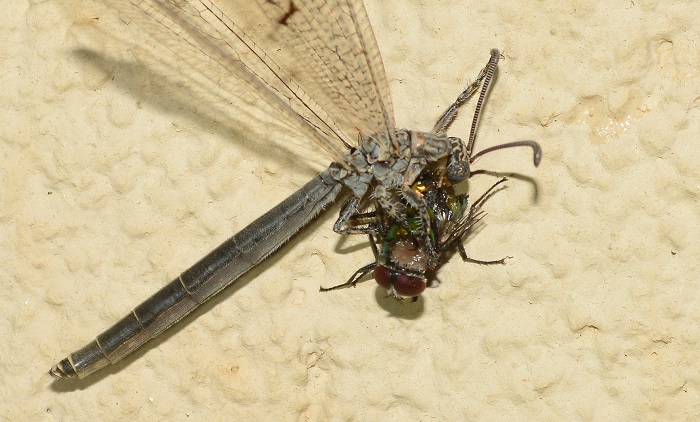This is the description of the Family Myrmeleontidae in the online guide to the Neuroptera (lacewings and antlions) of southern Africa
Myrmeleontidae is the largest lacewing family. There are currently 50 recognised genera and at least 180 described species in South Africa. Additionally there are many species that await description.
Fifty genera are known from South Africa: Annulares; Bankisus; Banyutus; Brachyplectron; Capophanes; Centroclisis; Crambomorphus; Creoleon; Cueta; Cymothales; Distoleon; Exaetoleon; Furgella; Fadrina; Golafrus; Hagenomyia; Jaya; Lachlathetes; Macroleon; Macronemurus; Maula; Myrmeleon; Nadus; Nannoleon; Nemoleon; Nesoleon; Neuroleon; Obus; Palparellus; Palpares; Palparidius; Pamares; Pamexis; Syngenes; Tomatares; Tricholeon.
Identification
Medium to very large sized (Wingspan 26-160 mm)
All have prominent but fairly short antennae. The compound eyes are fairly large and widely spaced.
Adults have two pairs of wings that are roughly equal in size. Their abdomens are long and slender and consist of ten segments.
Adult antlions superficially resemble dragonflies and damselflies. Antlions can be differentiated by having prominent antennae, smaller, widely spaced compound eyes and very intricately veined wings. Antlions also rest with their wings closed down the length of the body.

Near Carnarvon, Northern Cape
Photo by Ryan Tippett

Near Carnarvon, Northern Cape
Photo by Ryan Tippett
Food & Feeding
Adults and larvae are predatory and feed on other insects.
Adults mostly capture smaller flying insects in flight using their bristly legs. Prey is then taken to a perch before being consumed.
The larvae are all ambush hunters. They conceal themselves below the sand surface and grab unsuspecting prey that passes close by. The larvae of some genera are pit-fall trap builders (see Larvae below).

Near Carnarvon, Northern Cape
Photo by Ryan Tippett
Behaviour
Most adults are nocturnal and are readily attracted to lights. Adults are well camouflaged among vegetation during the day.
Larvae
Most species have free-living larvae that live in loose sand. A handful of genera demonstrate the famous ‘pit-building’ technique where the larvae capture their prey in conical pits dug into the sand.


Photo by Ryan Tippett

Near Carnarvon, Northern Cape
Photo by Ryan Tippett
Distribution
Antlions occur throughout South Africa and in all terrestrial habitats.

